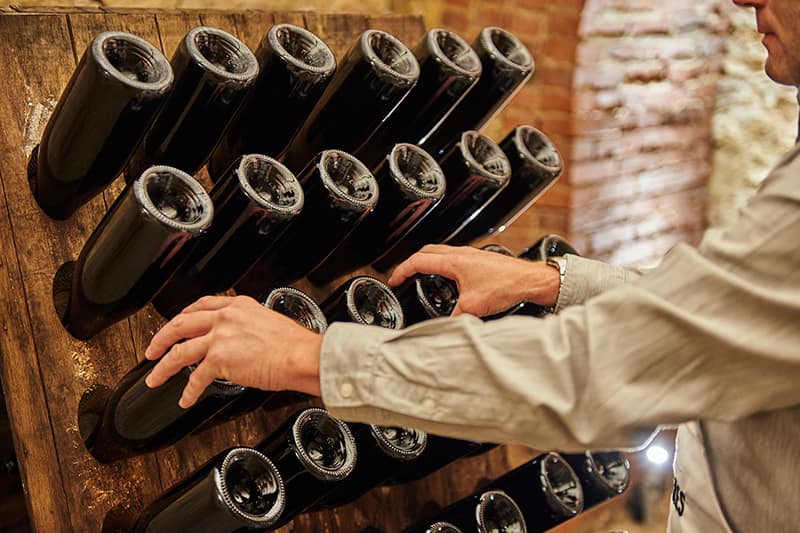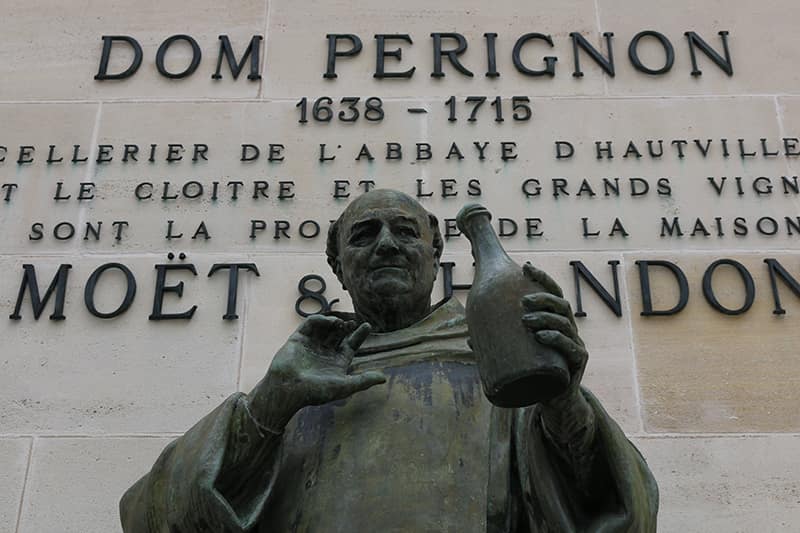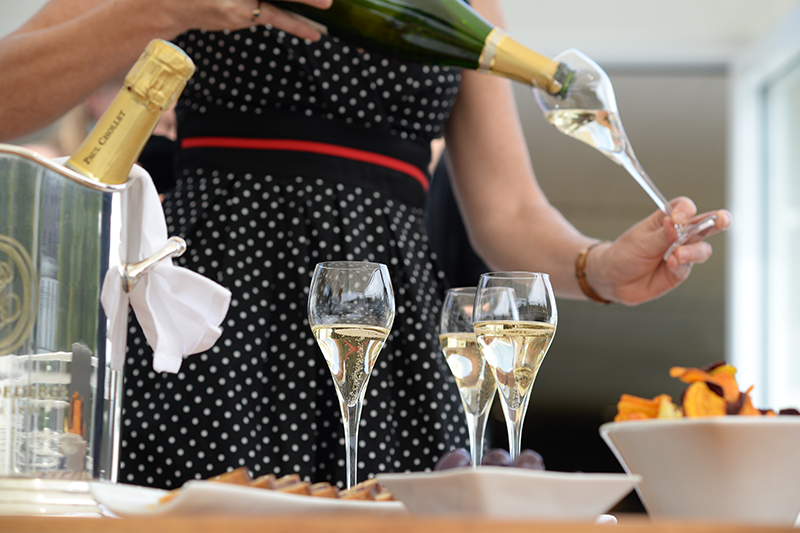Champagne: Across the globe, It’s the sparkling wine of choice due to its delicate and refined taste, whether you’re celebrating sporting success or launching a new vessel for its maiden voyage. But that’s not all champagne is good for, it’s also synonymous with symbolising wealth and success. So, why not open a bottle at your next party and toast your achievements?
Do you love champagne, but haven’t brushed up on your champagne knowledge? Not to worry; if your champagne etiquette needs some polish, then we’ve got you covered. From how best to serve champagne, to how long you can keep it, we’ve got your top 10 champagne etiquette questions, and we’re going to answer every single one of them!
1. What is champagne?
Champagne is the most famous sparkling wine in the world. It has an ABV (alcohol by volume) level of 11-13% and is made from pinot noir, chardonnay, or pinot Meunier grapes. It’s usually pale gold to pink in colour and quite dry in relation to other sparkling wines, like prosecco.
Champagne has tasting notes of apple, almonds, and citrus fruits. It’s light because of its fizzy nature. The bubbles in champagne are made from carbon dioxide, which is given off during the fermentation process. The bubbles in champagne help to gently balance the acidity on the palate.
2. Where is champagne made?
Champagne is made in Northern France in the Champagne region. This part of France was formerly known as Gaul under the Romans, and is known for its vineyards containing vines of pinot noir, chardonnay, and pinot Meunier grapes.
Traditionally, champagne was the local beverage used to toast the accession of French kings in Reims Cathedral. Today, champagne is protected within the Champagne region with a Appellation d’origine contrôlée, or Designation of Origin status that is recognised throughout Europe and other parts of the world. That means, if your champagne didn’t come from Champagne, it’s simply not champagne.
3. How old is champagne?
Champagne can be dated back as far as Roman times. During the 1st century AD, Romans started to grow vines in the Champagne region. Over hundreds of years, the Champenois cultivated them to produce what we recognise as champagne today. Though the seventeenth century French monk, Dom Pérignon, is widely known as the ‘Father of Champagne‘, he didn’t actually invent champagne, he simply perfected the making and bottling of it.
Many of the large champagne houses, such as Taittinger, Ruinart, Moët & Chandon, and Dom Pérignon were established in the eighteenth century when champagne became popular at the French royal court.
4. How should you open champagne?
The best way to open a bottle of champagne is to tilt the bottle away from your body (and anything breakable!) and gently pull out the cork, ensuring you have a firm grip around both.
Of course, there are much more extravagant methods of removing the cork, though. In the time of Napoleon, it was much more popular to slice the neck of the bottle in half at an angle with a sabre blade. The sabrage method of opening champagne separates the top of the bottle from the cork and collar so that the golden liquid can be freely poured. This type of champagne etiquette is actually still used for ceremonial occasions!
5. How many glasses of champagne in a bottle?
A standard bottle of champagne is 750ml and can be split into 6 servings. It’s recommended that each champagne flute is filled with a 125ml serving of champagne. Each glass of champagne has approximately 1.4 units of alcohol in it, which is the equivalent of a small glass of wine. You can pour a slightly larger glass of champagne than this if you use a wine glass, but this method isn’t used for champagne etiquette at prestigious events.
You may have heard the rumour that champagne can make you feel drunk faster, and this is no lie! The air bubbles in champagne and other sparkling wines result in the alcohol being absorbed into your blood stream much faster than if you were to drink a flat alcoholic drink. Champagne therefore has a slightly dizzying effect when it’s consumed quickly, and can result in what’s been historically called ‘giddiness’.
6. How long does champagne last?
An unopened bottle of champagne can last 3 to 4 years if it’s kept in the right conditions. Vintage champagnes can last a little longer; usually 5 to 10 years. It’s not recommended to drink a bottle of champagne if it’s more than 20 years old. As well as having lost some of its colour, old champagne can develop a flavour akin to vinegar, which isn’t very pleasant.
Once a bottle of champagne has been opened, it’s advisable to drink it within 24 hours, to ensure it’s at its fizziest and freshest. However, champagne can last as many as 3-5 days if stored upright in your fridge. The main problem with an opened bottle of champagne is retaining the carbon dioxide bubbles inside the bottle. You can buy champagne bottle toppers that slow down the process of a bottle going flat, and they work by preventing the gas from escaping. Good champagne etiquette would be to only serve a bottle of champagne on the day that it’s opened, though.
7. How should you pour a glass of champagne?
You should pour a glass of champagne at an angle. Tilting the champagne flute at around a 45-degree angle ensures that the champagne can be gently poured down the glass to slowly pool at the bottom. You should always leave half an inch or so empty at the top of the glass, to make sure that your guests don’t spill the champagne. Excellent champagne etiquette is usually observed at restaurants, where waiters drape a clean, white napkin over their pouring arm, just for show!
Champagne should never be poured straight down into a glass, as it is prone to fizzing, which fills the glass with bubbles and makes it difficult for guests to drink the liquid at the bottom of the flute. Filling a champagne flute in this way also encourages the carbon dioxide bubbles in the champagne to evaporate from the glass, resulting in the liquid inside the glass becoming flatter.
8. How should you store champagne?
You should store champagne in a cold, dark cellar and the bottle should be placed on its side. Placing the bottle on its side ensures that the cork remains moist and make it easier to remove when you open the bottle. This method also prevents oxygen from finding its way into the bottle through a shrunken cork.
Before serving, champagne should be chilled in a bucket of ice and kept at an ideal temperature of 7-9 degrees centigrade. A white napkin can be neatly draped over the top of the bucket to prevent some of the water vapour from escaping the bucket as the ice cubes melt. This method helps to keep your champagne colder for longer.
9. What is the best glass to use when serving champagne?
The preferred glass for serving champagne is a champagne flute. Originating in England in the eighteenth century, the champagne flute is thought to help champagne stay fizzy for longer. The shape of the glass helps to produce a steady stream of bubbles upwards and is thought to prevent the sparkling wine from going flat quickly.
Traditionally, champagne was served in a champagne coupe. Pre-dating the champagne flute and originating in the seventeenth century, this large, bowl-shaped glass was popular in the 1930’s. However, the champagne coupe fell out of favour in the 1950’s as the flute was championed as superior.
10. How should you hold a champagne glass?
The best way to hold a champagne glass is by the stem. This ensures that the champagne within the glass stays chilled. Holding the flute or coupe where the champagne is can result in the sparkling wine warming. Increasing the temperature of the champagne can result in a change of flavour and it can be less enjoyable to drink.
The correct champagne etiquette is to pinch the stem of your champagne flute or champagne coupe between your thumb and index finger, carefully resting your hand just above the base of the glass. If you need to better steady your glass, you can hold the stem with additional fingers. In this position, you should be able to tilt your wrist to sip the champagne inside your glass.
So, there you have it, from 1-10 we’ve answered your top 10 champagne etiquette questions. Now you’ll have no excuse, when you join us aboard a barge cruise on Panache through the Champagne region!
Practice your champagne etiquette on a Champagne cruise!
Guests on the 12-passenger Panache visit the boutique Grand Cru champagne house of Frerejean Frères, located in the middle of the Champagne countryside. The tour is followed by lunch in the family domaine, with ingredients harvested from its gardens. Champagne cruise passengers savour more bubbles with tastings at the world-renowned house of Moët & Chandon and the Maison Pannier winery with its labyrinth of medieval underground cellars. For more information delivered to your doorstep, order a free copy of our brochure or perhaps have a no-obligation chat with a member of our team via our Contact Form.
 English
English
 Spanish
Spanish French
French German
German Norwegian
Norwegian Portuguese
Portuguese Swedish
Swedish Italian
Italian Russian
Russian Simplified Chinese
Simplified Chinese Japanese
Japanese


